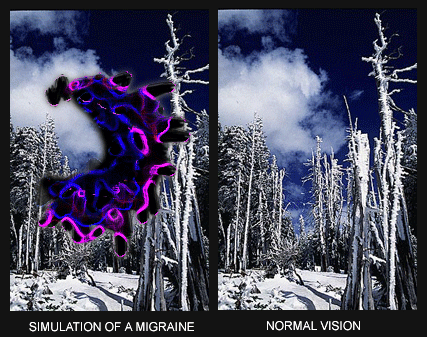Migraines
Migraines, which result from changes in brain blood flow, can produce severe headaches as well as disturbing visual experiences. They affect about ten percent of the general population. There are several different kinds of migraines, two of which can produce colour vision deficiencies or distortions: migraine headache with visual prodrome and ophthalmic migraine. In both cases, they are due to temporary spasms in blood vessels that cause them to constrict. This vasoconstriction reduces oxygen delivery to the photoreceptors, especially to cones, which have higher metabolic needs than rods. This in turn results in a transient loss or distortion of colour vision and central acuity for periods of several minutes up to an hour. This “migraine” that occurs does not necessarily involve any experience of a headache – often only visual distortions are present. The accompanying image simulates the flashes and ribbons of colour that someone suffering from migraine might experience.

While patient experiences can vary considerably, a common syndrome is a small, central blind spot (scotoma) with shimmering zig-zags of light within it. As the migraine progresses, the crescent-shaped blind spot gradually grows larger and may shift around the central field of view. As the visual distortion subsides, a headache may develop. This form is known as a migraine headache with visual prodome. In the absence of a headache during the vasoconstriction, it is termed an ophthalmic migraine.


